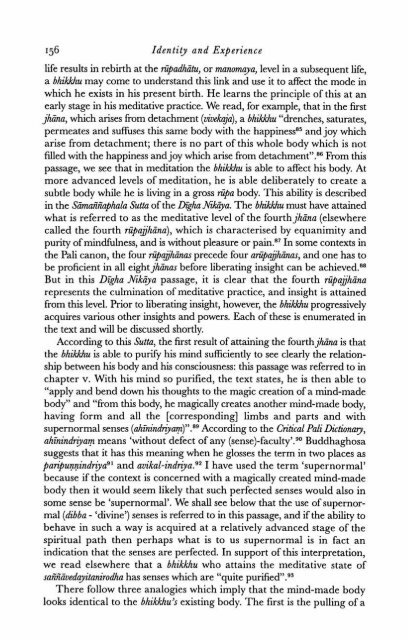Identity and Experience_Hamilton_1996
Identity and Experience_Hamilton_1996
Identity and Experience_Hamilton_1996
You also want an ePaper? Increase the reach of your titles
YUMPU automatically turns print PDFs into web optimized ePapers that Google loves.
156 <strong>Identity</strong> <strong>and</strong> <strong>Experience</strong><br />
life results in rebirth at the nipadha'tu, or rnanmayn, level in a subsequent life,<br />
a bhiMu may come to underst<strong>and</strong> this link <strong>and</strong> use it to affect the mode in<br />
which he exists in his present birth. He learns the principle of this at an<br />
early stage in his meditative practice. We read, for example, that in the first<br />
jhina, which arises from detachment (vivekaja), a bhiWchu "drenches, saturates,<br />
permeates <strong>and</strong> suffuses this same body with the happiness8= <strong>and</strong> joy which<br />
arise from detachment; there is no part of this whole body which is not<br />
filled with the happiness <strong>and</strong> joy which arise from deta~hment".~~ From this<br />
passage, we see that in meditation the bhiWGhu is able to affect his body. At<br />
more advanced levels of meditation, he is able deliberately to create a<br />
subtle body while he is living in a gross nipa body. This ability is described<br />
in the Simaiiiiaphala Suttu of the @ha JVi&ya. The b M u must have attained<br />
what is referred to as the meditative level of the fourthjhina (elsewhere<br />
called the fourth rzipajjhina), which is characterised by equanimity <strong>and</strong><br />
purity of mindfulness, <strong>and</strong> is without pleasure or pain.87 In some contexts in<br />
the Pali canon, the four nipdjjh6na.s precede four aru'pajhiinas, <strong>and</strong> one has to<br />
be proficient in all eight jha'nas before liberating insight can be achieved.88<br />
But in this DQha JVikiiya passage, it is clear that the fourth ripajhtina<br />
represents the culmination of meditative practice, <strong>and</strong> insight is attained<br />
from this level. Prior to liberating insight, however, the bhikkhu progressively<br />
acquires various other insights <strong>and</strong> powers. Each of these is enumerated in<br />
the text <strong>and</strong> will be discussed shortly.<br />
According to this Sutta, the first result of attaining the fourth jhina is that<br />
the bhikkhu is able to purify his mind sufficiently to see clearly the relationship<br />
between his body <strong>and</strong> his consciousness: this passage was referred to in<br />
chapter v. With his mind so purified, the text states, he is then able to<br />
"apply <strong>and</strong> bend down his thoughts to the magic creation of a mind-made<br />
body" <strong>and</strong> "from this body, he magically creates another mind-made body,<br />
having form <strong>and</strong> all the [corresponding] limbs <strong>and</strong> parts <strong>and</strong> with<br />
supernormal senses (~hinindnyam)".~~ According to the Critical Pali Dictionaly,<br />
ahinindnjam means 'without defect of any (sense)-fac~lty'.~~ Buddhaghosa<br />
suggests that it has this meaning when he glosses the term in two places as<br />
paripunnindriyagl <strong>and</strong> avikal-indr~ya.~* I have used the term 'supernormal'<br />
because if the context is concerned with a magically created mind-made<br />
body then it would seem likely that such perfected senses would also in<br />
some sense be 'supernormal'. We shall see below that the use of supernormal<br />
(dibba- 'divine') senses is referred to in this passage, <strong>and</strong> if the ability to<br />
behave in such a way is acquired at a relatively advanced stage of the<br />
spiritual path then perhaps what is to us supernormal is in fact an<br />
indication that the senses are perfected. In support of this interpretation,<br />
we read elsewhere that a bhikkhu who attains the meditative state of<br />
saKEiuedayitanirodha has senses which are "quite purified".93<br />
There follow three analogies which imply that the mind-made body<br />
looks identical to the bhikkhu's existing body. The first is the pulling of a


